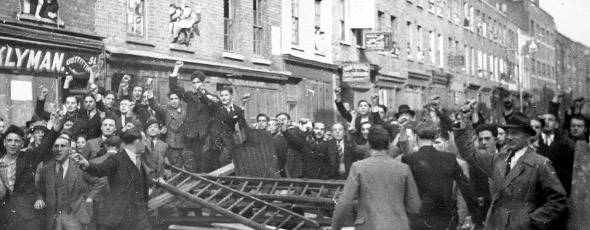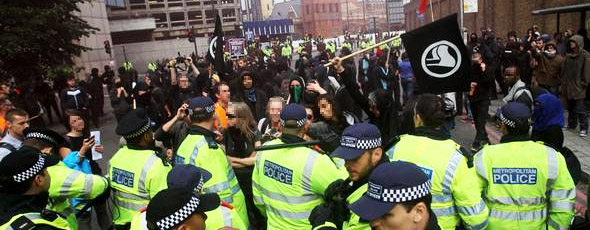
One of the kettles that hothoused anti-fascist protesters for several hours on Saturday just so happened to be a mere toss of a cop’s truncheon away from Cable Street: scene of the folkloric 1936 battle where the amassed inhabitants of East London ensured that Mosley’s fascists and The Met left under no illusions as to who those streets belonged to. Another irony, not immediately known to many present, was that the several hundred of us being kettled (and about to be arrested) were being held under a law originally drawn up in reaction to the marches of Sir Oswald Mosley and his ‘Blackshirts’. Whilst our section 12s and 14s are slightly more postmodern amendments to the law, the original Public Order Act of 1936 legislated against things like the wearing of uniforms by paramilitary groups and stipulated that routes had to be agreed with the police prior to any march.
This underscores the primary similarities between the events of 1936 and what happened this past weekend. On both occasions, fascists and anti-fascists were almost entirely kept apart by police; the main clashes were all between anti-fascists and the cops; the EDL, like the British Union of Fascists (BUF), had applied for permission for their march via the appropriate channels; several centrist voices called for the march to be banned but such calls were rejected on both occasions.
Sir Oswald Mosley was about as establishment a figure as you could get. Son of a baronet landowner (a distant relative to the royal family), he was formerly both a Tory & Labour MP before founding the BUF in 1932. He was also married to the daughter of Lord Curzon, formerly Viceroy of India and Conservative foreign secretary. But of course, the King of England in the year of the Battle of Cable Street was himself a known Nazi.
What’s key is to dispel this myth that fascism is a phenomenon that bubbles up from an ignorant working class. The EDL itself is partly funded and directed from behind the scenes by the likes of Alan Ayling (aka Alan Lake), a millionaire ex-City financier who described Anders Breivik’s mass murder of children as merely being “chickens come home to roost”. Also influential is Lake’s fellow “anti-Islam” crusader, Ann Marchini, who runs a buy-to-let property empire from her £1.6m mansion in Highgate. The cultural and class signifiers of football hooligan-type marching thugs may well be seen as vulgar by rich backers, but they share the white supremacy and nationalism and are more dangerous. EDL leader, Tommy Robinson (who has even more names than Grant Shapps), once summed up how such a coalition might work:
“We’ve been meeting with top political people for a year about this and now we’re getting close. We’ve been sitting down with a couple of lads who are posh-speaking, public school boys, who have been in politics before, and we’re discussing with them where it can go.”
Mosley’s BUF had the support of Lord Rothermere’s Daily Mail for a time, just as The Daily Star has given glowing coverage to the EDL in the past. The point, however, is that television, radio, tabloids and broadsheets can disseminate racism and white supremacy whilst hiding it behind euphemisms, discussions of language, religion or integration. Who needs to build a fascist party up from scratch when the liberal democratic state has “racist vans” or talks about “British jobs for British workers”?
After his attempts at parliamentary change had foundered and following an educational visit to Mussolini’s Italy, Mosley decided to take his politics to the streets. While the main target for EDL scapegoating is the Muslim community (today predominant in Tower Hamlets), the Blackshirts targeted the sizeable Jewish population in the East End of the 1930s. Anti-semitic assaults by fascists were growing and windows of Jewish-owned businesses were routinely smashed. But there was also a societal backdrop of a more pervasive anti-semitism. It was not uncommon for people to be denied tenancy agreements or jobs specifically because they were Jewish. Just as with Islamophobia, attacks on Muslim people and mosques have spiked since Woolwich; what cannot be ignored is that racism and discrimination in society is institutional and structural. And, as Sarah Glynn has outlined, the fight against racism and the fight for better housing in the working class neighbourhoods of the East End dovetailed with each other – both with Jewish immigrants in the 1930s and Bangladeshi ones in the 1970s.
As previously mentioned, the initial response to the BUF’s planned march from several mainstream voices was for it to be banned. A petition of over 100,000 signatures, many from Jews, encouraged by political and community leaders, asked for the march to be forbidden, but Stanley Baldwin’s government rejected such calls, stating that it would be undemocratic. Following the decision, Labour leaders, The Daily Herald newspaper and The Board of Deputies of British Jews effectively urged people to stay away from the march. Instead, over 250,000 Jews, Irish, Communists, Anarchists, Trade Unionists, anti-fascist Londoners of all persuasions, flooded the streets and back alleys of East London, defending their neighbourhoods and their right to live in them. This is compared to approximately 3-4,000 fascists and 6,000 police.

Just as was the case on Saturday, the dynamic was one whereby the fascists’ march was the “democratically sanctioned” one and so the police’s stated mission was to facilitate their protest. What they were greeted by was the organisational and physical embodiment of the phrase “They Shall Not Pass.” There were improvised barricades made to block several streets and corners using overturned lorries, building materials and trams (with the help of the sympathetic tram drivers.) Men, women and children fought the police with rocks, broken up paving slabs and chair legs. Marbles were rolled under the hooves of police horses, like a scene from Home Alone. Elderly women and housewives threw milk, rotten vegetables and the contents of their chamber pots from the upstairs windows when police came near their houses. Phil Piratin, leader of the Communist Party at the time, recalled:
“It was along Cable Street that from the roofs and the upper floors, people, ordinary housewives, and elderly women too, were throwing down milk bottles and other weapons and all kinds of refuse that they didn’t any longer want in the house onto the police. The Battle of Cable Street is known for this reason. It was there that the police really had to fight for themselves, not for the fascists.”
The entire mounted police division of London had been mobilised and countless baton charges were rolled out but the police could not clear the route for Mosley to march his black-shirted men and women through Stepney and Tower Hamlets. The scale of the operation was unprecedented. The Daily Worker newspaper’s report the following day describes the police methods in a way we might recognise:
“The police called every modern device into action to help them in their activities. Dozens of wireless vans were stationed at strategic points. Two planes were maintaining an aerial reconnaissance, whilst from every policebox plain-clothed men, who were as conspicuous as they would be inconspicuous, were keeping in touch with headquarters.”
The Police Commissioner called the march off and redirected a furious Mosley toward Embankment; the march tailed off into a damp squib while spontaneous street parties erupted back east. Around 150 demonstrators were arrested (though many were also de-arrested by comrades), 175 injured and, quite hilariously, several policemen were kidnapped.
On Saturday, things were very different. There was a decent turnout of anti-fascists (around 4,000 altogether), but there were probably as many police (none of whom were kidnapped) and estimates for the EDL are around 600. The meeting point was Altab Ali Park (named after a 25 year old Bangladeshi garment worker racially murdered in 1978) just up the Whitechapel Road from East London Mosque. Here protesters were subjected to the same stale speech repeated ten times by various ‘community & faith leaders’, local politicians and union reps, and celebrity activist journalists. Littered with buzzwords and a grossly co-opted version of the word ‘community’, people were acting like fascism was an entirely external moral force that arises from nowhere but is simply “evil” and “ignorant”.
The exception to this rule was 98-year-old Max Levitas who let out an impassioned cry for direct action, numbers on the streets and the need for the people of East London to confront fascism head on. “Yes, I’m a Communist,” he stated proudly as the dignitaries around him on stage shuffled nervously. Levitas fought at Cable Street when he was twenty-one and spoke with pride about a time when solidarity wasn’t a word to be sniggered at.
The heirs to the self-organisation and community uprising of Cable Street, are today’s community uprisings to which we must aspire – Quebec, Chile, Egypt and even Madison, Wisconsin. Antifa at least sought to take their own direct action, fully cognisant that a racist police and a racist state cannot be trusted to oppose fascism and will never be your friend. It was right to leave the park and seek out the EDL. We don’t want them anywhere, never mind just keeping them out of the particular place where the police allow us to protest. This is what made the triumphalism of Unite Against Fascism (the “official organisers” of the counter-protest as far as the media, the EDL and the rest of the hierarchically-minded are concerned), all the more risible. While they were releasing victorious press statements, hundreds of us were being herded onto double-deckers and bussed to police stations all over (and outside of) London to have our DNA and fingerprints taken.
They crowed hollowly: “No Pasaran”. The truth is that the EDL were never going to pass the UAF, not because of them but because the police weren’t willing to let the EDL march into the heart of Tower Hamlets. Had they actively tried to facilitate such an incursion, then who knows, perhaps we would have seen something more redolent of the mass defiance of Cable Street. As it turned out, we were to find out later, the UAF had actually been made aware that the police had intended to carry out mass arrests of any protesters who left the vicinity of Altab Ali Park – information they opted not to share with others.
When I emerged from Colindale Police Station at midnight, following three hours in a kettle, three hours handcuffed on a bus and four more in a custody cell, all for basically being in a space that the state had arbitrarily deemed – without telling us – that I wasn’t allowed to be in, I saw real solidarity and mutual aid. The friendly, not necessarily familiar, faces of people doing arrestee support. People sitting on the ground, in the middle of the night, at a suburban police station, waiting to give strangers hot soup and home-prepared dishes. That’s community.
By Michael Richmond | @Sisyphusa
![]() This work is licensed under a Creative Commons Attribution-NonCommercial-ShareAlike 3.0 Unported License.
This work is licensed under a Creative Commons Attribution-NonCommercial-ShareAlike 3.0 Unported License.









